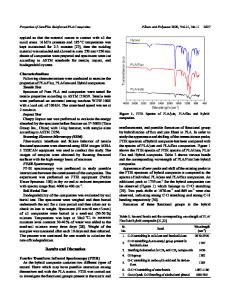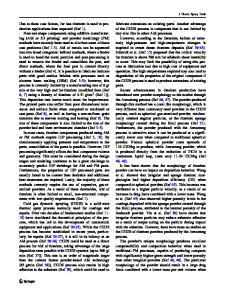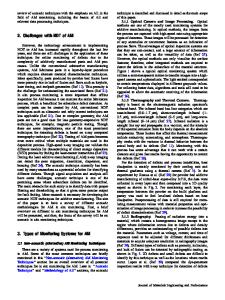Determination of thermal and thermomechanical properties of biodegradable PLA blends: for additive manufacturing process
- PDF / 1,113,634 Bytes
- 8 Pages / 595.276 x 790.866 pts Page_size
- 14 Downloads / 314 Views
Determination of thermal and thermomechanical properties of biodegradable PLA blends: for additive manufacturing process C. O’Mahony1 · E. Gkartzou2 · E. U. Haq1 · S. Koutsoumpis2 · C. Silien1 · C. A. Charitidis2 · S. A. M. Tofail1 Received: 31 August 2019 / Accepted: 16 May 2020 © Akadémiai Kiadó, Budapest, Hungary 2020
Abstract The purpose of this study is to investigate the thermal and viscoelastic properties of polylactic acid (PLA) blends with the aim of optimizing properties for fused filament fabrication. Additive manufacturing opens many possible applications for materials in processing and application. Determining the most effective thermal and viscoelastic properties is required for printing. PLA blends can be tailored to suit design specification, printers and printing parameters. Quantified analysis of differential scanning calorimetry and rheology is applied to the qualitative property of “printability”, with preferences of thermal stability, melt temperature, shear thinning effects and zero shear viscosities. This paper intends to further bridge this gap between physical properties and material printability. Keywords Additive manufacturing · Calorimetry · Fused filament fabrication · Polylactic acid · Printability · Rheology
Introduction Since its inception in the 1980s, additive manufacturing has become a technology of choice due to its ability for the rapid prototyping (RP) of complex shapes and geometry directly from computer-aided design (CAD). The measurement or characterization of functional, dimensional, structural, mechanical and physico-chemical properties of the 3D printed devices and its constituent materials underpins process optimization, inspection and monitoring and product quality assurance. While 3D printing can make some very complex and unconventional shapes and structures by additive manufacturing, a robust quality assurance scheme still alludes manufacturers due to the lack of availability of appropriate and enough tools, methodologies and characterization expertise. Thus, the success of 3D printing in creating shapes and structures into useful products will depend on how firmly one can assure that properties in the desired * S. A. M. Tofail [email protected] 1
Department of Physics and Bernal Institute, University of Limerick, Co. Limerick, Ireland
Research Unit of Advanced, Composite, Nano Materials and Nanotechnology, School of Chemical Engineering, National Technical University of Athens, 9 Heroon Polytechniou St., Zographos, 15780 Athens, Greece
2
shape or structure meet certain accepted, pre-defined standards, as well as the cost of production remains competitive. In other words, the market uptake of products made via 3D printing will happen when parts produced will confirm the intended properties through appropriate measurement. Fossil fuel-based materials are extensively used in industrial applications; however, there is increasing awareness of their adverse effects on the environment and their limited resources. Considerable attention has been focused in the
Data Loading...











